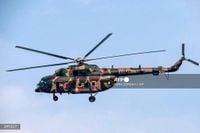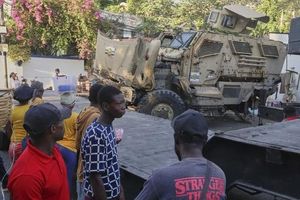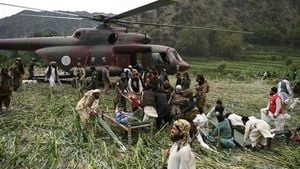On Monday morning, tragedy struck the mountainous region of northern Pakistan when an army MI-17 helicopter crashed during a routine training flight, killing all five people on board. The incident, which occurred around 10 a.m. local time in the Diamer district of Gilgit Baltistan, has once again drawn attention to the risks and recurring tragedies associated with military aviation in the country.
According to multiple officials and agencies, the helicopter was engaged in a test landing on a newly proposed helipad in a popular tourist area when things went catastrophically wrong. As reported by AFP and corroborated by the Associated Press, the aircraft developed a technical fault mid-flight, causing it to go down and subsequently catch fire. The crash claimed the lives of two pilots, two crew members, and one flight engineer—each of whom was engaged in what should have been a routine operation.
Abdul Hameed, a senior police officer in Diamer district, described the grim aftermath: "Among the killed were two pilots and three technicians." His words echo the deep sense of loss felt by the local community and the military establishment alike. Faizullah Faraq, the regional government spokesman, confirmed the technical nature of the fault and noted that authorities have already launched an investigation into the incident. "The helicopter apparently went down in the Gilgit-Baltistan region due to a technical fault and then caught fire," Faraq stated. Details remain scarce as investigators sift through the wreckage to piece together the sequence of events.
This latest crash is not an isolated incident. Pakistan has witnessed a troubling number of military and government helicopter accidents in recent years, raising questions about the safety of such operations. Just last month, another helicopter carrying relief supplies to the flood-hit Bajaur region crashed in bad weather, killing all five people on board. In September 2024, six people perished when a helicopter went down in northwest Pakistan due to engine failure. And in 2022, a particularly devastating crash in Balochistan claimed the lives of five servicemen and a top army commander during flood relief operations.
These repeated tragedies suggest a pattern that is difficult to ignore. While technical faults and challenging weather conditions are often cited as causes, the frequency of such incidents has prompted calls for a thorough review of maintenance protocols, pilot training, and the suitability of aging aircraft for missions in Pakistan's demanding terrain. The MI-17, a Russian-designed workhorse of military and civilian fleets worldwide, has a reputation for reliability, yet even robust machines can falter under persistent strain or if maintenance lapses occur.
The crash site itself—nestled within the rugged, scenic hills of Gilgit Baltistan—adds another layer of complexity. The region is known for its breathtaking landscapes and attracts tourists year-round, but its high-altitude, mountainous topography poses significant challenges for aviation. Helicopter flights in such areas are often undertaken for both military and civilian purposes, from troop transport to rescue missions and infrastructure development. Test landings on newly proposed helipads, like the one attempted on Monday, are crucial for expanding access to remote communities and supporting local economies. Yet, as this tragedy demonstrates, they are not without significant risk.
As news of the crash spread, the country mourned the loss of the five individuals who died in service. Social media channels filled with tributes to the fallen pilots, crew, and engineer—each remembered for their professionalism and dedication. For many Pakistanis, the incident brought back memories of past crashes and reignited debates about the safety and management of military aviation assets.
According to AFP, a local police official confirmed that the helicopter crashed during a test landing on the newly proposed helipad. The official added that the area is a known tourist destination, making the accident all the more alarming for both local authorities and visitors. Fortunately, no civilians were harmed in the incident, but the loss of life among the crew is a stark reminder of the dangers inherent in such missions.
Government and military officials have promised a full investigation into the circumstances surrounding the crash. As Faizullah Faraq noted, "Authorities are investigating the incident." The hope is that lessons can be learned, and steps taken to prevent similar tragedies in the future. In the meantime, the families of the deceased are left to grapple with their grief, supported by a nation that has grown all too familiar with the cost of such accidents.
Pakistan's military relies heavily on helicopters for a wide range of operations, from disaster relief to counterterrorism and infrastructure support. The country's geography, marked by mountains, deserts, and flood-prone plains, often necessitates aerial mobility that only helicopters can provide. However, the demands placed on these aircraft—and the people who operate them—are immense. Routine flights can turn perilous in the blink of an eye, as Monday's crash so tragically demonstrated.
In the aftermath, there have been renewed calls for investment in modernizing the country's helicopter fleet and improving safety standards. Aviation experts point to the need for rigorous maintenance schedules, comprehensive pilot training, and the adoption of advanced safety technologies. Some have also suggested that older helicopters, like the MI-17, should be phased out in favor of newer models better equipped to handle the rigors of Pakistan's environment.
For now, the investigation into Monday's crash continues. Authorities are examining the wreckage, reviewing flight logs, and interviewing witnesses in an effort to determine the precise cause of the technical fault. It is a painstaking process, but one that is essential for restoring confidence in the safety of Pakistan's military aviation operations.
As the country awaits answers, the memory of those lost in the Diamer district crash will linger. Their service and sacrifice underscore the risks faced by those who operate on the front lines—whether in times of peace or crisis. And while the skies over Gilgit Baltistan may one day be safer, the lessons of this tragedy will not soon be forgotten.






